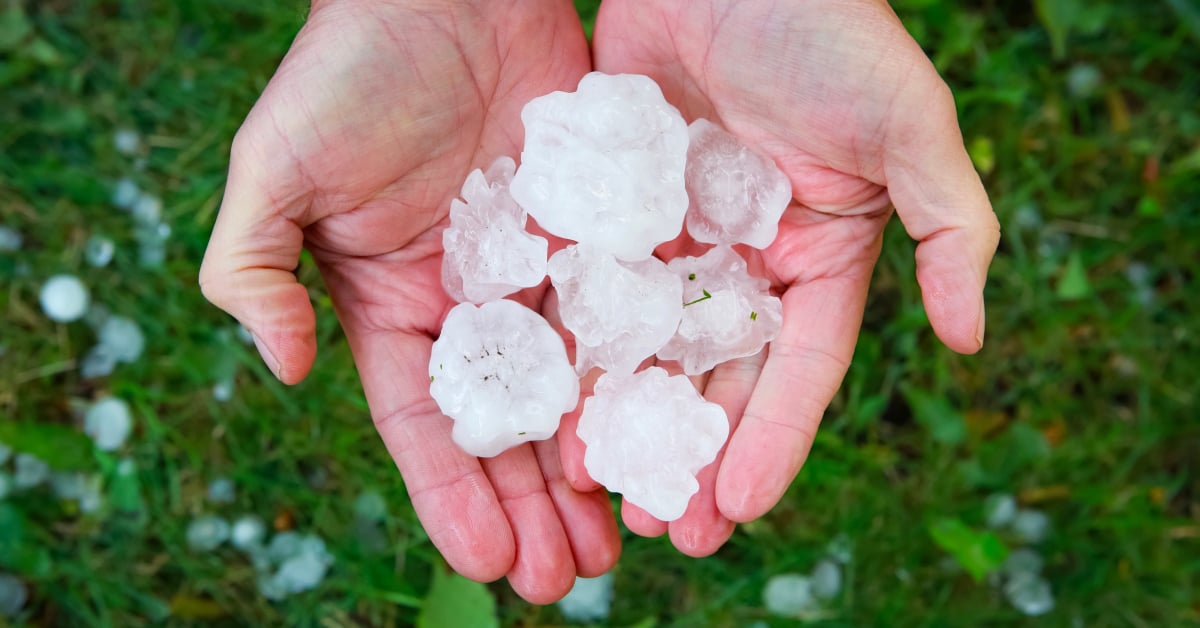Why is climate change supercharging Europe’s biggest hail?
9 October 2025 | By: Newcastle University | 4 min read
New research shows that as the climate warms, hailstorms across Europe may become less frequent. But when they do occur, they could be more destructive than ever, especially in the south.
New findings from Newcastle University and the UK Met Office shows that climate change is reshaping the nature of severe hail, with significant consequences for people, infrastructure and agriculture across the continent.
Contents:
- The relationship between climate change and changing weather
- Hail in a changing climate
- Fewer storms, but bigger stones
- A future of tropical-type hailstorms in Europe
- Preparing for future storms
The relationship between climate change and changing weather
Climate change doesn’t just mean hotter summers, it’s reshaping the entire pattern of weather experienced on Earth.
As global temperatures rise, the atmosphere holds more moisture and energy, fuelling more intense downpours, stronger storms, and longer dry spells. Weather extremes that were once considered rare are now becoming more frequent and severe. From flash floods in northern Europe to prolonged droughts in the south, shifting weather patterns highlight how climate change influences not only average conditions but also the day-to-day extremes that affect communities, infrastructure, and ecosystems.
Hail in a changing climate
In addition to floods, fires, and heatwaves, hailstorms can also bring devastating impacts.
But what exactly is hail?
Hail is solid precipitation in the form of balls or lumps of ice called hailstones. It forms within thunderstorm clouds, where strong rising air currents carry raindrops and ice particles into very cold, high-altitude regions. These particles then grow by collecting and freezing more water droplets until the air current can no longer support their weight. This is when they fall to the ground, as hailstones.
Hail larger than 2 cm in diameter is classed as severe, and once hailstones reach 5 cm or more, they are considered very large, and at that size, they can smash car windscreens, puncture roofs, flatten crops, and even threaten aircraft safety or result in injuries or - in rare cases - fatalities.
Published in Nature Communications, a new study by Newcastle University in collaboration with UK Met Office climate experts used cutting-edge European-wide climate simulations at kilometre-scale resolution to understand how hail might evolve in a warmer world. These high-resolution models allow scientists to capture the fine details of storm processes that coarser models miss, shedding light on how hailstorms might look in the future.
Fewer storms, but bigger stones
The research found that in a high-emissions scenario where we do not cut greenhouse gas emissions, severe hail is likely to become less common overall. However, when hail does form, the stones themselves could regionally be much larger.
‘Our findings indicate that the effects of climate change on severe thunderstorms are more complex than previously thought, and high-resolution models can produce results that differ significantly from earlier research. Society may need to prepare for less frequent, yet more damaging hail events locally, in a 5-degree warmer future.’ Dr Abdullah Kahraman, Senior Researcher in Severe Weather and Climate Change
But why might this happen?
The answer is in the balance between atmosphere and storm dynamics.
As temperatures rise, hail tends to form higher in the atmosphere. This gives stones longer to melt before they reach the ground, meaning fewer make it to the surface before melting. Therefore, as temperatures rise, you would expect fewer hailstorms, as most of the hailstones are small and they are more prone to melting.
Also, a warmer climate can weaken large-scale circulation, which in turn affects the vertical profile of winds, or wind shear – a key component of thunderstorm organisation. This reduced wind shear doesn’t allow thunderstorm downdrafts to be separated from the updrafts, favouring weaker rising air currents, and producing an environment less favourable for storm growth, lifetime, and intensity.
The weakening of large-scale circulation patterns can also cause slower-moving storms and lead to blocking patterns. As a result, weather systems stall in place which then leads to high rainfall accumulations.
As for the larger hailstones, higher moisture content in the atmosphere can lead to higher instability, which then leads to higher vertical velocities in thunderstorms when the vertical wind shear is already sufficiently high. Though this might be rare, on the occasions when it does happen, hailstones will have the chance to grow larger before they fall.

The aftermath of hailstorms can be damaging and dangerous to anyone caught in one.
A future of tropical-type hailstorms in Europe
However, researchers found that future warm seasons feature a warmer thunderstorm type similar to hail-producing storms found in the tropics. In these areas, the largest hailstones can still reach the surface.
‘These results are very concerning. They imply we need to be prepared for tropical-type hailstorms impacting Europe in the future, associated with very large hailstones that can cause severe impacts. This possibility also extends to the UK, although the risk of hail here remains low into the future.’ Professor Lizzie Kendon, Head of Climate Projections at the UK Met Office and Professor of Climate Science at the University of Bristol
This means that while Central and Northern Europe, including the UK, may see fewer hailstorms overall, southern regions like Italy and the Mediterranean basin could face more intense and damaging hail, particularly in autumn and winter.
‘As a society we need to be better prepared for unprecedented extreme events and this study shows that future storms in the Mediterranean could bring giant hail, with devastating impacts.’ Professor Hayley Fowler, Professor of Climate Change Impacts
In recent years, hailstorms in Europe have led to damaged cars and roofs, crop destruction in vineyards, orchards, and arable fields, and transport disruption, including delays at airports when aircraft are damaged.
Preparing for future storms
Extreme weather events are one of the most visible impacts of climate change, and this study suggests Europe must add giant hailstones to the list of growing risks. While fewer storms might sound like good news, the reality is more complex.
With the potential for tropical-type hailstorms delivering unprecedented damage, researchers stress the importance of early action. Building resilience now, through better forecasting, planning, and international cooperation, will be key to minimising impacts in the decades ahead.
While the models provide strong insights, uncertainties remain, particularly around how higher freezing levels might affect the largest hailstones as they fall.
The researchers highlight the urgent need for further investigations into how tropical-like thunderstorms in Europe might evolve and produce very large and damaging hail at the surface.
You might also like:
- read the full study: Kahraman, A., Kendon, E.J., Fowler, H.J., Short C. J. Future changes in severe hail across Europe, including regional emergence of warm-type thunderstorms. Nat Commun 16, 8438 (2025). https://doi.org/10.1038/s41467-025-62780-0
- find out more about our researchers:
- Dr Abdullah Kahraman, Senior Researcher in Severe Weather and Climate Change in the School of Engineering at Newcastle University
- Professor Hayley Fowler, Professor of Climate Change Impacts in the School of Engineering at Newcastle University
- Professor Lizzie Kendon, Head of Climate Projections at the UK Met Office and Professor of Climate Science at the University of Bristol
- Dr Chris Short, Scientific Manager of Regional Climate Processes and Projections at the UK Met Office
- read the earlier paper: Abdullah Kahraman, Elizabeth J. Kendon, Steven C. Chan, Hayley J. Fowler. Quasi-Stationary Intense Rainstorms Spread Across Europe Under Climate Change. Geophysical Research Letters (2021)
- explore more of our multi-disciplinary engineering research, including our water group, whose research addresses and mitigates the effects of climate change
Reference:
Kahraman, A., Kendon, E.J., Fowler, H.J. et al. Future changes in severe hail across Europe, including regional emergence of warm-type thunderstorms. Nat Commun 16, 8438 (2025). https://doi.org/10.1038/s41467-025-62780-0
